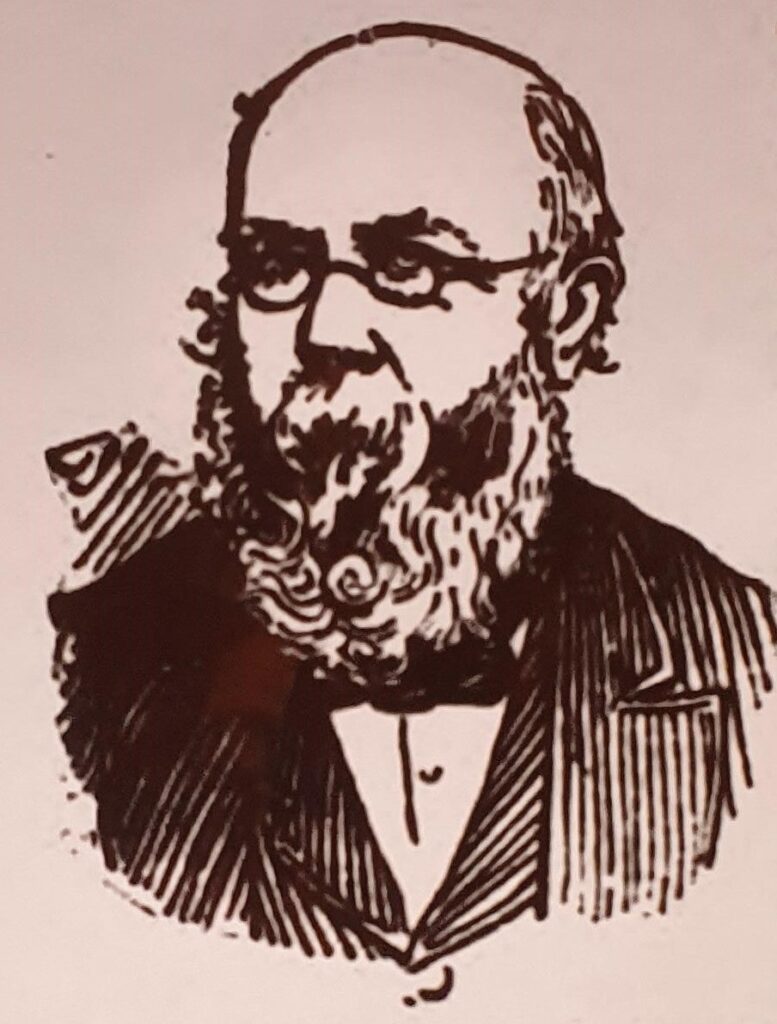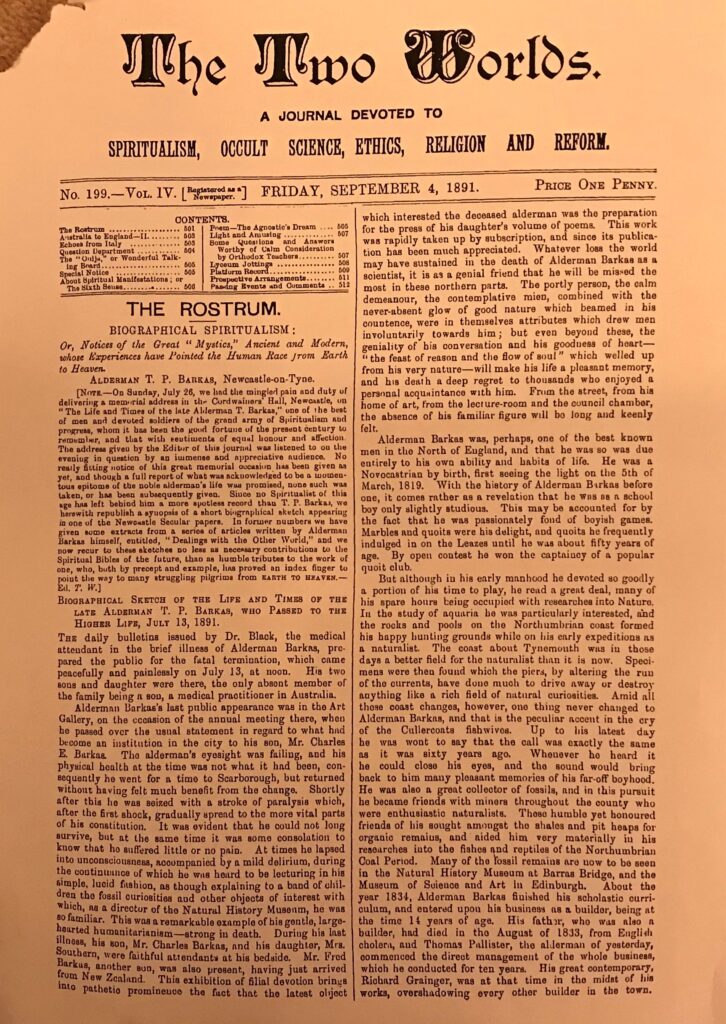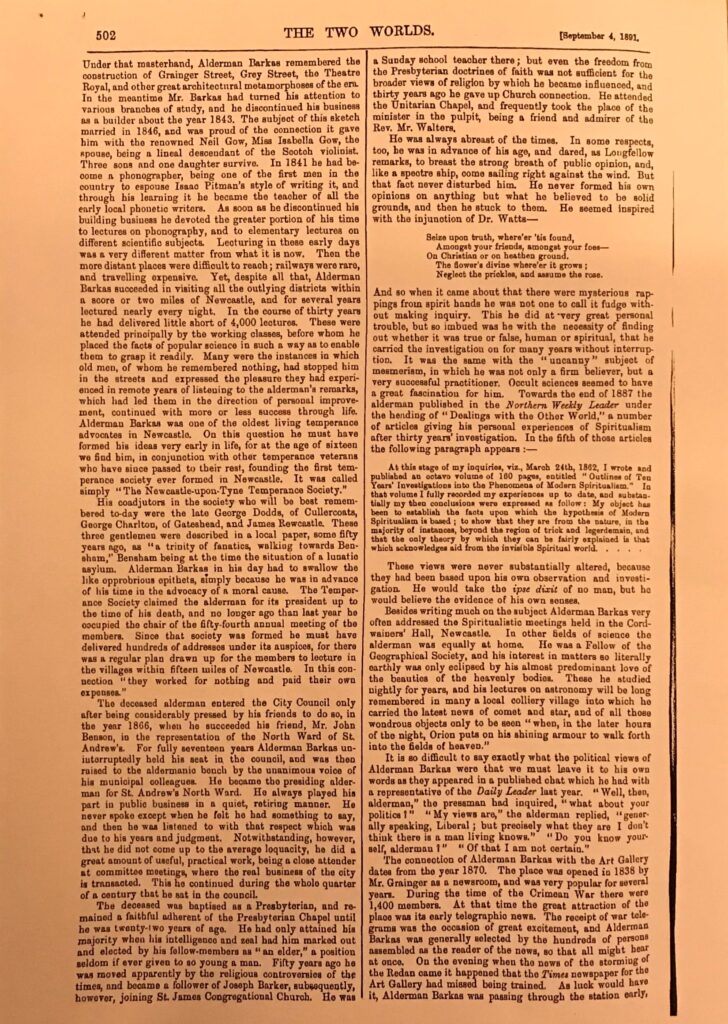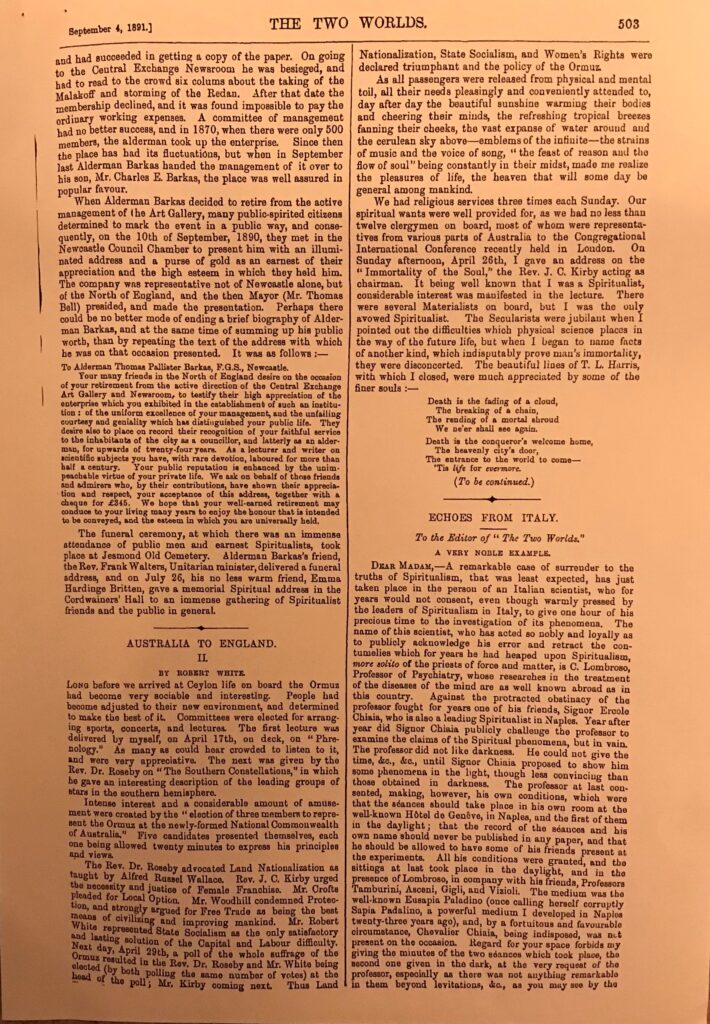ALDERMAN, AUTHOR, FATHER OF ISABELLA JANE SOUTHERN (VICTORIAN POET), INTELLECTUAL, MEMBER OF THE LIT & PHIL, SPIRITUALIST
Situated in the Unconsecrated/East Section of Jesmond Old Cemetery.

A prominent citizen and Alderman of Newcastle, Thomas Pallister Barkas was born in the front house, above the Coach and Horses entrance, Bigg Market, Newcastle, on the 5th of March 1819, the eldest child of William Barkas, a House Carpenter and Barbara Pallister. Thomas was baptised at the John Knox Presbyterian Chapel in the Groat Market.

Thomas married Isabella Gow, a descendent of the renowned Scottish violinist, Niel Gow, at St. James Chapel, Blackett Street, in 1846 and they went on to have seven children, William James (1847 – 1917), Isabella Jane (1849 – 1912), Thomas Pallister (1851 – 1851), Thomas Pallister (1852 – 1853), Frederic (1854 – 1932), Charles Edward (1856 – 1906) and Thomas Pallister (1858 – 1873).
As an aside, the history of the family business is quite interesting – Thomas Pallister (Thomas’ maternal grandfather) and William Barkas (Thomas’ paternal grandfather) were business partners. Thomas Pallister is in the 1811 Directory of Newcastle, trading as a House Carpenter in the Bigg Market. He was still trading alone in 1819 but by the 1824 Directory, he is in partnership with William Barkas, trading as Pallister and Barkas in Newgate Street. By 1827, Pallister and Barkas are trading in High Friar Street, where they stayed for many years. They were, obviously, close friends as well as business partners, and they would have been very happy that their partnership was further sealed when young William Barkas and Barbara Pallister were married in 1816, with their first child, Thomas Pallister Barkas being born in 1819.
When William Barkas died, of ‘English cholera,’ in 1833, Thomas Pallister continued to trade under the name of Pallister and Barkas for the benefit of himself and William’s family. When Thomas Pallister died in 1836, he left his estate in the hands of three Executors – Roger Barrow, Matthew Reed and Thomas Barkas (William’s brother and the children’s guardian) – for the benefit of his four grandchildren, ‘our’ Thomas Pallister Barkas, and his two sisters, Barbara Ann and Elizabeth and his brother, William. The Executors were to run the business of Pallister and Barkas and the profits were to be used for the maintenance and education of Thomas and William until Thomas reached the age of 21 and then his grandsons were to inherit the business and premises, with Barbara Ann and Elizabeth bequeathed a house each, from the two he owned on Marlborough Crescent, when they reached the age of 21. He also gave two houses in Eldon Street to William, his house in Prudhoe Street to Barbara Ann, a house in Union Place, Gateshead to Elizabeth and £200 to Thomas!! Clearly, the Pallister and Barkas business had been doing well…..
Although the Executors carried on the business, Thomas was associated with the business from his Grandfather’s death, which would have made him 17, when the Executors authorised him to receive and give payments.
After gradually letting the Pallister and Barkas building company subside, selling the business to William Carr, an employee, Thomas’ life took on an altogether different direction, attending evening classes to supplement the deficiencies in his education. By 1840, he was delivering lectures in the New Lecture Room, Nelson Street on subjects as diverse as electricity, galvanism and magnetism, “at which time those subjects were little known.” The following year, after becoming a close friend of Isaac Pitman, the inventor of ‘phonography’ or shorthand, he became a pioneer of the system in the North East, delivering many lectures on the subject; indeed, it was claimed that most of the press reporters in the region at that time took their first lessons in shorthand from Thomas.
As part of his quest for self – improvement, Thomas decided that he should become a purveyor of literature and, in 1845, subsequently acquired the book selling business of Mr. Robert Fletcher at number 26 Grainger Street, Newcastle, selling it on as a going concern to Mr. E. J. Blake in 1870.
Thomas was a prominent member of the Newcastle Society for the Investigation of Spiritualism, addressing the Spiritualistic meetings held in the Cordwainers Hall, Newcastle, arranging test seances and introducing Elizabeth D’Esperance (1855 – 1919), the prominent Victorian medium, to the wider general public. A number of articles on spiritualism, entitled “Dealings with the Other World,” were published in ‘The Two Worlds; a Journal devoted to Spiritualism, Occult Science, Ethics, Religion and Reform.’ The publication itself was founded in 1887 by Emma Hardinge Britten and was the voice of Spiritualists in the north of England. On his death, the publication devoted over two pages in providing a biographical sketch of his life and times, describing it as a “humble tribute to the work of one, who, both by precept and example, has proved an index finger to point the way to many struggling pilgrims from earth to heaven.“



As well as being on the Committee of the ‘Lit and Phil’ in Newcastle, Thomas was also instrumental in founding the ‘Newcastle upon Tyne Temperance Society’. He also found the time to write many books on several subjects, including geology and ‘spiritualism’, with grand titles such as the ‘Illustrated guide to the fish, amphibian, reptilian and supposed mammalian remains of the Northumberland carboniferous strata’ in 1873 – a review of the book at the time advised that, “although we regret that we cannot apply very high praise to this work as a scientific production, it must be frankly admitted that Mr. Barkas has shown for many years a most enthusiastic perseverance in the prosecution of paleontological studies“ – and ‘Outlines of ten years investigations into the phenomena of modern spiritualism’ in 1862. Many of the fossils he recovered from the Tyneside coastline ended up on display in the Natural History Museum, Barras Bridge; the modern day Great North Museum or the Hancock Museum, as many Tynesiders continue to know it by.
In 1866, Thomas was persuaded to enter Newcastle Town Council; he was re-elected in due course each year until 1883 where he was then subsequently appointed as an Alderman for St. Andrew’s North Ward.
In partnership with Thomas Hall Tweedy, the famed Newcastle carver and gilder, in 1870 he founded the Art Gallery in the Central Exchange Building in Newcastle. This was also a news room and a concert room; later, a small theatre was also attached. On retiring from the active management of the Art Gallery in 1890, Thomas was presented with a cheque for £345 as a token of the esteem in which he was universally held by the citizens of Newcastle.
Following a stroke and a short illness, Thomas died on the 13th July 1891, aged 72, with his wife, Isabella, pre-deceasing him, aged 60, in 1882. The Morpeth Herald, dated Saturday, July 18, 1891, gives a little more detail surrounding Thomas’ death, stating that he died, “between twelve and one o’clock on Monday afternoon, at his residence, 28, Lovaine Place, Newcastle, life passing gently away. About three weeks ago Ald. Barkas was stricken with paralysis while at the Art Gallery, and was conveyed to his residence. It was, at first, thought he might possibly live for some years, though in a paralysed condition. His condition, however, became worse, and for a considerable portion of the intervening time he was unconscious, but had brief spaces of consciousness, during one of which last week he expressed the hope that he would shortly be relieved from the weariness which life had become to him, partly owing to his incapacity for taking food.”
Thomas’s obituary in The Newcastle Daily Chronicle, dated Thursday, July 16, 1891 informs us that, “The funeral of the late Ald. T.P. Barkas, of Lovaine Place and late lessee of the Central Exchange Art Gallery, took place yesterday at Jesmond Old Cemetery, in the presence of a large concourse of people. In the first mourning coach were Mr. Fred and Mr. Charles Barkas, sons of the deceased gentleman; and in the second, Mr. Southern, son-in- law, Master Willie Southern, grand-son, and Mr. G.W.W. Watson. The coffin, which was of polished oak, with brass mountings, bore the following inscription – “Thomas Pallister Barkas. Born 5th March, 1819. Died 13th July, 1891.” The coffin was covered with flowers. The Rev. Frank Walters, of the Church of Divine Unity, conducted the funeral service, and at the close, delivered an impressive address. The Rev. gentleman then offered up a short prayer; after which many passed the open grave, taking a last look at the resting place of one of the most esteemed and valued citizens of Newcastle.”
On July 26, 1891, Emma Hardinge Britten, the founder of the Two Worlds publication, gave a memorial Spiritual address in the Cordwainers’ Hall to an immense gathering of Spiritualist friends and the public in general.
In terms of his children, William James Barkas attended Durham University Medical School and qualified as a physician and surgeon in 1868, emigrating to Australia in 1876 – he died in Sydney in 1917. Click on the name for more about Isabella Jane Barkas/Southern. The first two children, both named Thomas Pallister, died in infancy, with the third Thomas Pallister dying, aged 14. Frederic Barkas obtained a Bsc. in Chemistry and emigrated to New Zealand in 1881 to take up a Lecturing position at Lincoln College near Christchurch – he died in Timaru, New Zealand in 1932. Charles Edward Barkas went into partnership with his father and Thomas Hall Tweedy in their business at the Central Exchange Building in Grainger Street.

When Thomas Hall Tweedy retired in 1883, the business continued but traded as Barkas and Son and then, when Thomas retired in 1890, Charles continued on his own. He completely renovated the Art Gallery in 1892, with business doing very well until 1901, when the building was ravaged by fire and everything was lost. Charles was also Managing Director of Elswick Cycles in Northumberland Street and later an Estate Agent at 1, Eldon Square. Charles married Elizabeth Jane Watson in 1888 in Gateshead and they had three children. On dying in 1906, Charles estate was valued at £21,000.
SOURCES:
Family History of Thomas Pallister Barkas.
The Two Worlds Journal (September 4, 1891)